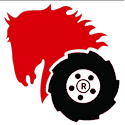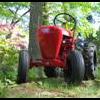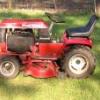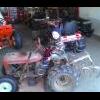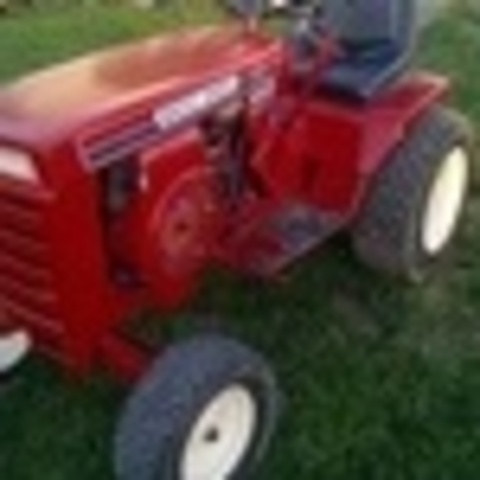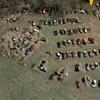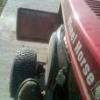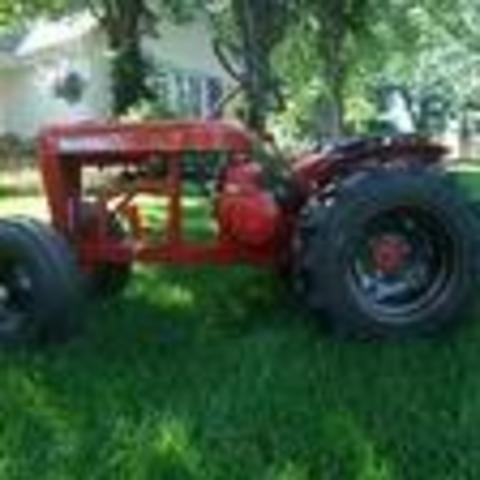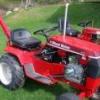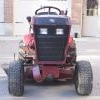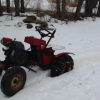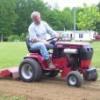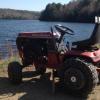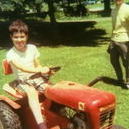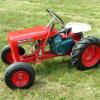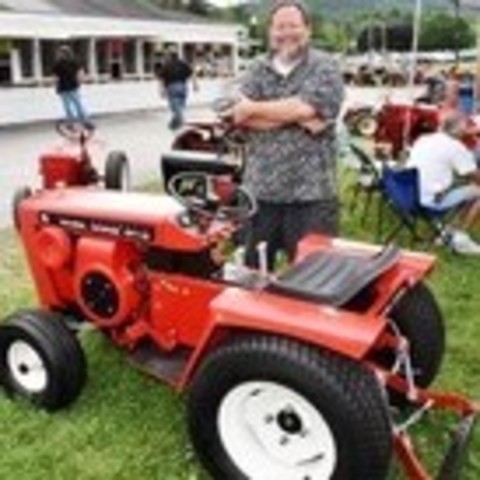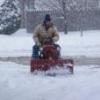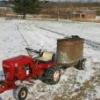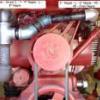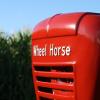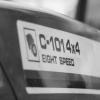Leaderboard
-
in Posts
- All areas
- Markers
- Marker Comments
- Marker Reviews
- Articles
- Article Comments
- Article Reviews
- Classfieds
- Classified Comments
- Classified Reviews
- Wiki's
- Wiki Comments
- Wiki Reviews
- Blog Entries
- Blog Comments
- Images
- Image Comments
- Image Reviews
- Albums
- Album Comments
- Album Reviews
- Files
- File Comments
- File Reviews
- Posts
-
Custom Date
-
All time
November 28 2011 - November 27 2025
-
Year
November 26 2024 - November 27 2025
-
Month
October 26 2025 - November 27 2025
-
Week
November 19 2025 - November 27 2025
-
Today
November 26 2025 - November 27 2025
-
Custom Date
07/26/2015 - 07/26/2015
-
All time
Popular Content
Showing content with the highest reputation on 07/26/2015 in Posts
-
8 pointsThis 551 has been under a tarp in a barn for the last 15 to 20 years. The PO bought the tractor new in 1961 and has had it every since - 54 years. I knew the tractor was there, but I had not seen it for at least 20 years. This past week he called and said it was time. We made the deal on this and a Bronco 14.. The 551 is missing the foot rests, has the wrong decals, and the fluid has worked over the front rims, but it has the correct H55D - 2113 -(serial 55209). The muffler and belt guard are both there and it looks to be in nice shape for tractor 54 years old.
-
4 points
-
4 pointsMy Originl Cab has both... snaps, and a zippered bottom, on its replaceable windshield.
-
3 pointsHere are a few interior shots and an up close of the motor so you can see how mint it is.. Wow Denny I didn't realize it has been 6 weeks! It seems like it has been an eternity. If I didn't decide to bring it to work and work on it in the back warehouse I wouldn't have finished it this year. The weather has been kinda rotten this summer and at home I was working on it outdoors.. I guess i did okay because I was also able to give my Crestliner and its trailer a makeover as well. I'm done working on boats for the rest of the summer so if any of you guys find a boat that needs a makeover don't send me the Link because I'll be too busy out on the water!
-
3 pointsThe Dunphy is done! I just picked the boat up from the upholstery shop and it looks great.. The motor is original to the boat, I did the needed maint. on it and she purrs like a kitten. I spent a few days detailing the motor and it looks almost new..Maiden voyage will be sometime this week. The last time this boat was out on the water was 43 yrs. ago!
-
2 pointsHey fellas its been awhile. I had to get back in the garden tractor game. However since I moved to NC its hard to find anything at what I would consider a good deal or a good price. From what I can tell people either hold on to them, value them like they are gold or just scrap them. Well I was checking craigslist and I came acrossed this beauty. It is a Economy tractor, it has hydraulics, and came with a front dozer blade, and a turn over plow. However the connecting rod broke, so I am going to have to do something about this engine, either rebuild or repower.
-
2 pointsMy new 3 point implement what do you all think? It will be fun at tractor shows.
-
2 pointsThe 314-8 is a very good choice. It will handle any garden chores you throw at it. You would be hard pressed to find a better or stronger manual transmission in a garden tractor. The combination of that cast iron Kohler and that 8 speed doesn't get any better.
-
2 points
-
2 points
-
2 pointsYou can't go wrong with a 314-8. One of the best models Wheel Horse made.
-
2 pointsThe 314-8 is IMHO one of the all time greats. The rear end is stout and will handle your plowing chores.
-
2 pointsBeautiful job, Mike. One of my biggest complaints, not just with Wheel Horse (theit cab manufacturers, i.e. "Original Tractor Cab, Co.) but pretty much all cab manufacturers, is the fact that most do not have zippered-in, replaceable windows. I've often thought of making my own cab covers and doing just that.
-
2 pointsI saw your Tacoma at the show Lane. Wheel Horse red is a nice color. I almost bought an access cab, 4x2, but walked away at the last minute. It was not certified, and with the winters that we have here, not getting a 4x4 would have been a big mistake. And that tiny thing they call a bench seat, Even my 7 year old grandson had a problem with that. The dealer that I am probably going to finalize a deal with has just lowered all four of his 2013's by $500.00 to $1000.00, making the deal a little sweeter. As far as towing, the empty weight of my 6 x 12 utility trailer is about 900 lbs. With 4 average Wheel Horses, the total weight would be about 3500 lbs. So even without the factory towing package I would be okay. I probably would have already purchased something, but as usual, life gets in the way. Had to replace the well pump, my current Chevy Astro needed a new front wheel hub/bearing, the wife's Subaru A/C went up, and on and on... Here is a picture of the unit I have been looking at. Actually there are two, one is white, and this silver one.
-
2 pointsWell finally got it all together and tried it out and it is getting looser every time I drive it so it should be just fine. Thanks for the help
-
2 points
-
2 pointsJohnny Bucket makes an electric actuator sleeve hitch that works independent of the rockshaft. I'm not sure if it could be adapted to a classic Wheel Horse due to the rear chassis configuration, but I did put one on my 523Dxi. I use my single stage snowthrower on this tractor and a scraper blade for up by garage doors. My 520xi has the blade with a UHMW edge. At some point my intention is to wire this tractor and get the frame portion from JB so that I can use this tractor as well with the sleeve hitch. You might want to consider this for your new 522xi.
-
1 pointThe onan parts manuals (and service manual) lists both a 20amp and a 35amp stator for the P216/P218/P220. Does anyone know if this can be put in without switching out the flywheel? (Obviously with the 35A regulator) They list two flywheels for different specs, but I cant correlate that to stator size. @boomers_influence or anyone else?
-
1 pointSo I decided to restore the C121 I aquired, I took every bolt out and I am in the process of rebuilding, I need some help with the small screws that go into the block for the points cover, I cant find anywhere a diagram showing what size they are and I have every document I could find on the web, I misplaced them.
-
1 pointJust take time, get help. Its quite hard to lift a Magnum 18 by yourself to a counter top. them key ways are sharp! needles to say i didn't complete the task alone
-
1 point
-
1 pointTime to take those covers off anyway to give the engine a good cleaning. And as far as the mice is concerned, its time for you to invest in a good barn cat! I have a good little barn cat named Bibi and she is worth her weight in gold for keeping mice and snakes away from the house and barns and out buildings.
-
1 pointThis might be the ones Kohler Engines X-67-59-S SCREW, WASHER HD TAP #8-32X3/8" USE 25 086 99-S NOT ILLUSTRATED http://www.partstree.com/parts/kohler-engines/engines-horizontal/k301-47648-kohler-k301-engine-k-series-wheel-horse-12hp-9kw-specs-4710-47835/breaker-ignition-cont-tp-2097/ Hardware is listed on the first lines Have often thought an Allen capscrew would work better because it would stay on the Allen key. The originals are a slotted fillister head. Garry
-
1 pointHave you checked to make sure it has the rear cable lift system and rocker shaft to lift a rear hitch? If that is on it, great! If not, you will need to find one here on the classifieds or one at a swap meet.
-
1 point
-
1 point
-
1 pointPullstart - the Bronco 14 is still on the trailer. I will post some pictures the first of the week. Jake - Since the decals have been replaced, the tractor has probably been repainted. I do know that the PO always stored the tractor in a garage or barn. I am going to ask him the next time we visit.
-
1 point
-
1 pointWhat's nice about the 24" inchers is that Farmall Cub Wheels are the same. My PK wheels were rotted from calcium, Got these about 40 miles down the road from a Cubbie guy! Already had the Farmall A rear weights.
-
1 pointAfter selling my C-200 with loader to MRC, which I of course regret, and the John Deere 112 with Johnson loader, I always wanted to find another one. I saw this for sale mounted on older Sears rider. It was listed on Craig's List and Ebay. I e-mailed the seller and asked if he would sell the loader separate and how much or if he was interested in any trades. He gave me a price and asked me what I had for trade. I have been sitting on that little Kitty Track dozer for a few years and seeing as the amount of work it needed and the cost just to have replacement tracks made ($800 with the chain links!), I offered it up in trade. He accepted and I picked it up yesterday up in Massachusetts (Actually really close to Wallfish). Apparently it was designed for the Bolens 800, 900 and 1000 series tractors. It has a trip bucket but they offered a hydraulic tilt kit. I have the manual that shows all the parts so that may be in order. Going to drop it off at the sandblasters next week and have him go to town on it. I believe he also does epoxy priming too. Today the kids helped me off load it and we rolled out the Diesel Ranger to see how it would look if I mounted it on it. I think the ranger is a touch to small. Maybe a "CERTAIN 702" might be in order to mount it on ! No matter what tractor it does end up on I'll have to fabricate the front and rear mounts which is really no big deal. These little midget loaders are almost impossible to find and this one is never going to leave my sight!
-
1 pointAwesome! Just awesome! I need to know how she works in a few short months! Curious about how much the front chains will help. Looks like the rear chains should do a good job even over the ags. I'm a big fan of the double cross links! Dennis Thornton
-
1 pointI don't have any pictures. I had a couple made by a friend with a milling machine out of nylon. The nylon i picked up at an old mill site I was measuring to draw up Handicapped Access. I was being divided up for other business. If the blocks haven't been turned around that works one time. I had used both side of mine. If you could get some one to mill the slot across the piece shown above. Then you could saw them out and drill the holes. That piece is a little thick they are only around 1".square
-
1 pointThe other thing to mention here is that "valve wear" consists of wear at several locations. The following assumes that the valve seat (the part in the engine block) and valves contact face (also called a "seat" as shown in the image below) are in known good condition and do not need to be re-ground or replaced due to breakage or wear. It also assumes the camshaft lobes are also not worn out. The main wear locations are on the upward face of the valve seat, and the bottom surface of the valve itself. Also, you can have wear on the valve stem and/or the camshaft lobe, but if the engine oil is replaced regularly this is usually very little compared to the valve and seat. As the engine wears, the valve "sinks" into the valve seat, because of wear at both the seat and valve, effectively closing the gap between the valve stem and the camshaft lobe. The most important factor of setting this clearance is to make absolutely certain that the end of the valve stem is ground absolutely flat and perpendicular to the valve stem. Most home shops do not have the fixture, or the correct grinding wheel. to do this "correctly", and we try to do it by hand on a normal grinding wheel we find in most of our garages. Though this might work, in the long run it will shorten the life of the engine more than if you did it on the correct equipment, or had it done by a local machine shop. The procedure is pretty simple. You rotate the engine till both valves are closed (compression stroke), and both valve stems are no longer in contact with the camshaft lobes. You measure the gap that exists between the valve stem and camshaft lobe, and you write that gap on the top valve with a Sharpie. You then look up the spec. for your engine, remove the valves, and either grind them yourself or carry them down to the machine shop to have them ground. The difference between the number you wrote on the top of each valve and the spec. is how much will be removed from the valve stem. n example, I find the intake valve clearance is 0.004" and I know the valve and seat are good, I take off 0.004 - 0.006" off the end of the valve stem, re-install the valve in the engine, and measure the gap again. I should now be between 0.008 - 0.010 clearance when the engine is rotated to the same location. I always shoot for the middle to give me a margin of error, but always "sneak up to" the correct dimension VERY slowly so I don;t trash a valve or be forced to re-cut a valve seat to make up the difference. Same process for the exhaust valve. When they are both within spec. I move along to the next step in the rebuild process. A LITTLE BACKGROUND Say I find an engine which needs a valve job done before I can trust the engine to be installed in a restore. I certainly do not want to get everything painted and installed, then find the engine is failing and have to take it all apart again, messing up the paint job on both the tractor and the engine. Therefore, when I redo a machine, the engine is about the third thing on my list to restore after the wheels and frame are completed. I dis-assemble the engine completely, knock out the valve guides and seats, replace them with new parts, and cut the seats and ream the guides to size. If the seats are cut, then the new valves have to have the matching angles cut to the seat area on the bottom of the valve, so that when assembled and are closed in the block, the valves make an air-tight seal. But your not done yet. Once the seats of both parts are cut to match, you still have to "lap" the valves and seats as a pair. This is a process where you put some lapping compound (very fine polishing paste) on the seat and valve faces, spin the valve in place (usually using a drill or milling machine) and polish the two surfaces so they match exactly. This is not normally possible to do in the home garage because not many of us have the appropriate tools, the drill press or mill, and the lathe to do it right. Sure you can do it with standard shop tools, and it will work, but it will not be as long-lived if you don;t do it with a certain level of precision. This is why its best for most of us to take it to a machine shop and let them do it with the right tools and equipment. Anyway, so now the vales and seats are cut and lapped to perfection. This is the stage at which we are talking about here. Now the valve stem to cam lobe clearance is adjusted to spec. The only way our engines are going to make their maximum HP potential is if the valves and piston(s) are air-tight and close-fitting within their respective tolerances. K321 Valve Clearances: Intake: 0.008-0.010 in. Exhaust: 0.017-0.019 in.
-
1 point
-
1 point
-
1 point
-
1 pointI am not sure what changes on angles and belt clearance for this model and layout but this is the Wheel Horse proper prescribed way for this model. The layout is available on parts diagrams. For C195 and the 60 inch Ariens sourced deck.
-
1 pointThe RJ info seems pretty easy until the RJ-58s and 59s! <grin> I've tried to summarized what I have and I'm also hoping someone will also chime in on the earlier models. The info comes from all over and I take no credit for any of it! Thanks to ALL and sorry if I didn't credit everyone since I did quote some folks and not others. My intent is to eventually present simple facts of what is known but also what is suspected in a very concise format and hopefully be able to copy all the data in a still meaningful way to the already existing spreadsheet. If all goes as hoped, the "Gallery" could also support this project with pictures with captions, brochures and anything and everything that helps. Please review and help me add anything missing and correct anything wrong! I encourage "nit picking"! And what I have for 1955 through 57 info is pretty slim! 1950s RJs, The garden tractors of the 50s are referred to as RJs, Ride-Away Jr.s. with mid engine and straight axles. Note:The 1960-61 models were also mid-engine but with cast axles though the 701 axle was yet a different style. The pre-1958 models have the Pond transaxle with the chain case on one side. The 3-piece UniDrive was introduced with the RJ-58, and the last model to use it was the 401. 1955 RJ-25, Briggs 2.5 HP engine, Single-piece channel frames, and a belt-drive system with "POND" stamped on the rear axle. Simple grill, with no name or extra designs added. 1955 RJ-35, Kohler k-90 or Clinton B-1200, Single-piece channel frames, and a belt-drive system with "POND" stamped on the rear axle. Simple grill, with no name or extra designs added. 1956 RJ-25, Briggs 2.5 HP engine, Single-piece channel frames, and a belt-drive system with "POND" stamped on the rear axle. Simple grill, with no name or extra designs added. 1956 RJ-35, Kohler k-90 or Clinton B-1200, Single-piece channel frames, and a belt-drive system with "POND" stamped on the rear axle. Simple grill, with no name or extra designs added. 1957 RJ-35, Kohler k-90 or Clinton B-1200 No RJ-25? No Briggs? Wheel Horse name was added to the grill. 5 lug rear wheels 1958 and 1959 RJS. Now enters the controversy... Was there even a 59JR? ___________________________________________________________________________________________________________________________________ MikesRJ Jul 04, 2011 This is a personal opinion, and is sure to create a firestorm of controversy but, I seriously doubt there ever was an "official" RJ-59 ever built by Wheel Horse. No one has ever produced a serial number tag reading "RJ-59". In the years I have been seeking information on the RJ058/59 (which is extensive), it is my opinion that WH manufactured RJ-58's for two years. The final stages of production, roughly 2500 machines or less, used some additional parts derived from the upcoming 1960 400 machine, and hence had some minor differences to their predecessors. Other than that I don't believe there really is an RJ-59, period. RJ-58/59: That said, the model/serial tag is located on the top side of the left-front frame, immediately behind the hood where the hood mounts to the frame. See image below. The only way to get an idea of date of manufacture, short of the tag, is to look at the casting date on the transmission center section. The date code is cast immediately to the right of the hole in which the shifter passes. That date code is the letter and numbers indicating month and year of casting. Let me know what the cast date is and I can tell you roughly when the transmission was manufactured. Not a conclusive method if the trans was replaced but ballpark if it is original. _________________________________________________________________________________________________________________________________ And Stevasaurus: Some will say.."If you do not have the sticker that says it's a 59...then it is a 58". "I tend to agree with some of the purists here...if you do not have the sticker...it is a 1958." ________________________________________________________________________________________________________________________________ Anyways, continuing... 1958 RJ-58 The 1958 Rj-58 model introduced a new three-speed transmission.,the Uni-Drive, Model 5003 that Elmer Pond designed and came with the Clinton B-1290 and the Kohler k-90. The RJ-58 and RJ-59 used a "new" welded angle-iron frame. Early 1958 RJs: Round rear wheel hubs with only 3 holes which came from the Walk Aways. Leather shifter boot RJ-35 style front rims (Not sure what that means?) Rear hitch had separate welded flat pieces vs. the newer style one piece which was bent into shape Some of the foot pedal and lift arm pieces looked more crude the way they were cut and welded. The seat pan was a little bit deeper RJ-58/59 - welded steel clutch pedal, no contour stiffening lines in the hood, single throttle control, no choke cable. RJ 58/59 - 5003 transmission, if you look how the brake band mounts, the screws that hold the brake band are vertical mounted on the trans.. 1959 RJ-59 A solid seat pan was used on tractors in 1960 and some RJs which seem to be completely original also had a solid seat pan which could indicate a 1959 Some will have a height selector for the lift arm which was used on the 1960 tractors. Transmission casting code could also indicate 1959 1958/1959 --RJ-58 and RJ-59 used a "new" 3-piece uni-drive transaxle [Model 5003], as well as a "new" welded angle-iron frame. The Clinton model engine changed to the model B-1290 --which was still a 3.6hp engine. Corrections? Additions? Bound to be something I've mis-typed at least! Thanks for all the help so far! Dennis Thornton
-
1 pointNot sure how many hairs we are going to end up splitting here...ie...maybe a suburban is 60 only, but all the mid-engines are nut-roasters. Now the RJ-58 / RJ-59...I know some guys that will tell you, "If you do not have the sticker that says it's a 59...then it is a 58". Like John said, the seat from the 1960's...or the casting dates on the trans would signal 1959. That is the rub...anyone could change this out and call it a 1959 (more rare), but it turns out it is a 1958 with a 60's seat or you found a casting with a 1959 date code. I tend to agree with some of the purists here...if you do not have the sticker...it is a 1958. Does anyone have a sticker that shows 1959??? I do not think so. Do you have the original paper work?? I'd like to see what Stevebo has to say about this...he said he did a lot of research. I think everyone should just relax a little here until we see how we want to try to do this. We all know about the exceptions to the rule, but we may not know about all the exceptions. That is the point. I think we want to have posts in here that we can move into the Wheel-Horseapedia with pictures so we can put this together. It should be helpful, it should be about a particular horse...we are trying to show what this horse has and (maybe) has not. We want some pictures taken from all sides of a correct horse...not just the right side. We would like the pictures put in here from a computer.(direct)..not from a link like Photobucket...so we do not lose them again. We are looking to move these posts of text and/or pictures into a format that is easy to search and see what is correct...for instance...400 suburbans (early) came from the factory with Clinton engines. It will be hard for us to move a post into the right spot if it is talking about 4 or 5 different horses...it will be easier if it is 5 posts talking about a horse by it self. We may end up getting some pictures that are correct, say "except for a belt guard"...that is OK as long as we know what is not correct and maybe what is should look like. This is going to be huge and will make Red Square interesting for quite some time. If you have any pictures (of all sides) of a certain horse and an explanation of what is correct...any brochures...documents...etc. Feel free to post it here...we do not have to start with round Hoods...short frame square hoods...black hoods...etc. We should be able to section this out and work with the information that we are receiving. I'm thinking that once we set up what we want to do here, any posts we can use, we will move into what we are building. We want to keep the integrity of the author of the post in-tact. Dennis and I are still talking about how this may work, waiting for Karl's input.....and anyone else's input for that matter. Looking more for ideas here, rather then horse knowledge at this point....but the last 2 pages does show why this needs to happen.
-
1 pointThe capsule should have an almost grease consistency lubricant. it is applied to the nylon (or some kind of plastic) follower in the points assembly. It lubricates the follower and the cam on a distributor shaft. Since your Kohler uses a plunger instead of a cam and follower it is unnecessary.
-
1 pointSounds to me like you are caught between a rock and a hard place. Maybe it would be best for you in the long run to do whatever mowing has to be done yourself. Its not easy being the responsible one in the family. I should know................
-
1 pointThe lube is used on a felt pad that rubs the distributor shaft in an old style car application. You don't have system so it is not needed.
-
1 pointStay away from R&L. Learn from my mistake. They quoted me $230 for a tractor and when it arrived in CT at the terminal they would not release it unless I paid $2300. Yes, thats not a typo. They said it was not classified correctly and as a piece of motorized machinery the classification code changed. And yes, they didn't feel a need to contact me. They took it upon themselves to re-classify it, inflate the rate, and still push it through. After three days of non-stop arguing I finally had to pay $1000 to release the tractor or face storage fees. My attorney said to chalk it up as a learning experience but I refused. I ended up filing a lawsuit against them in CT court and they agreed to settle outside of court. Never again. I use Fastenal.
-
1 pointHow about one of those cheap Harbor Freight fold up 4 X 8 trailers. Add some more wheels or camper jacks for stability. You can tow it around with another horse and fold it up when not in use?
-
1 pointJust walked in the door. 14 hours in a torrential rain. Good to be home. Glad you are enjoying the popcorn. Great seeing you all at the show. See you all next year.
-
1 pointI got to say a BIG thank you to Terry for this cool prize......for those who picked up their popcorn Terry hosted a raffle for this cool item.... A 1956 Ford F-100 Pickup truck modified with some custom decals featuring a 1956 RJ......how neat is this???
-
1 pointDo a search for 42 inch Auger, Deer Whisper had to replace one. It's a good post about just replacing the sprocket.
-
1 pointHave been meaning to post some pictures of my snow setup on the C160 for a while but hadn't got around to it. Finally have gotten to use it the past week or so, although after last winter I am certainly not complaining about having fewer opportunities to push snow so far this year. My setup for snow is some old Firestone "Town & Country" 6-12's that came with my 854 on the rear, and some surplus snow blower tires on the front. I've got some Wards wheel weights on the rear and WH weights on the front, plus a couple suitcase weights tucked into the rear for good measure. The blade is actually a newer 48" blade with a 5-position sector I came across, which I much prefer to the 42" / 3 position one I used on my old C120. On the recommendation from someone on here, I bought a pair of Cree 18W LED spot lights for the front (love them!), and put them on a mount I built to attach to the front hitch. I also added a set of LED strobes to make sure I can be seen. After using a Deere 140 H3 last year with a hyd lift/angle blade I was afraid I would regret getting rid of it and choosing the C160 as my snow mover for this year. I'm happy to report that so far, so good. I do wish it could lift the blade as high as the 140 could, but that is the only trade off I have experienced so far. The weights and skinny tires seem to work pretty well. They do spin on slick surfaces, but I think anything short of chains probably would. The tractor is much easier to steer than that 140 was, and so far haven't even come close to running out of power. I've actually been doing the neighbor's driveway to help him out and to get a little more seat time!
-
1 pointI got to thinking a few months ago that it might be interesting to use the family tree concept to map out the entire wheel horse family. It's easy to plot right from an RJ up to a black hood knowing that they evolved into round hoods, short frame, long frame, hydros, etc, etc I'm up for drawing this up, but might just need a little help as whilst I know my wheel horse onions - I'm by no means an expert I think as a point of reference it could be incredibly useful esp. when it comes down to swapping out engines, transmissions, etc. Here's a quick sketch of what I was thinking, thoughts??
-
1 pointI finally got a chance to tear into the C-160. When looking up what transmission gasket I was going to need to order to put it back together (P/N 5999), I came across a reference to the in-chassis gasket replacement Since it was the RH side that needed the bearing and seal, the procedure worked well for taking that half of the housing off without pulling the whole rear end out of the tractor. I wasn't sure what I would find when I opened up the transmission. I assumed I would find some debris, but the question was how much. Inside was a nice assortment of filings, bearing race pieces, needles and ball bearings. Wait, what, ball bearings? Oh yeah, the dreaded 1533 bearing, totally trashed. I proceeded hoping I could salvage one from a parts tractor. The axle shaft had a few grooves in it from running on the failed bearing, but based on what I saw I believe the seller's story about not running it after it failed and think that was probably just from pushing it around. The bolt heads on the diff also showed some contact wear from running without the support of the inner bearing. While none of the wear was necessarily good, it was better than I had feared. Just getting the remains of the outer shell of the old 1533 bearing out of the housing turned out to be quite a challenge. There was nothing left to grab on to. Even after cutting it with a dremmel in several places it put up a fight but I was finally able to get it to pop out. The same story on the outer bearing with only the outer shell left and nothing to grab. Just one cut with the dremmel and it fell right out. Despite attempting to be careful with the dremmel, I did get into the bearing races a little bit. I sanded them down to eliminate any burrs, so hopefully that doesn't come back to haunt me down the road. While I had it apart this far, I decided to pull the axle and gears out of the rear end and inspect the bearings on the LH side. Of course the hub on that side didn't want to come off, but a combination of penetrating oil, heat and the trick of using a spare hub to pull it off did finally persuade it to come. Thankfully the LH bearings looked good. With everything apart, I cleaned it all as good as I could, especially the pump inlet screen. With all the debris in there, I don't have alot of hope that I won't have to get into the pump and valve too, but the plan at this point is to put it back together and try it and see where I need to go from there.


